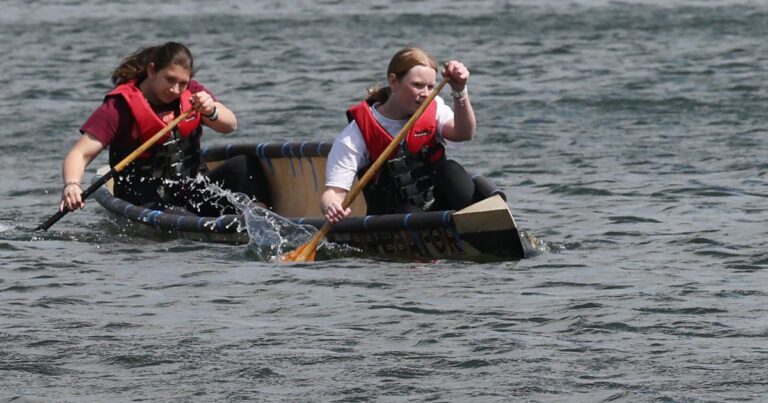CRATOR LAKE — Since last summer, students at universities in Virginia and West Virginia have been doing something not common on the water: building floating concrete canoes.
The design was tested Friday at a lake in Pulaski County.
The concrete canoe race is part of a larger symposium sponsored by the American Society of Civil Engineers (ASCE) at Virginia Tech. Six universities competed against each other. Virginia Tech, West Virginia University, Liberty University, Old Dominion University, University of Virginia, and Fairmont State University. A private high school, Miller School in Albemarle, also competed.
Virginia Military Academy was also scheduled to compete, but a problem occurred with their canoe before the contest began.
Before the competition, teams were given 50 pages of guidelines. Concrete was essential, but concrete admixtures were left to competitors.
Others are also reading…
Maura Harbaugh, one of Virginia Tech's two team captains, said she opted for an unusual addition to the concrete mix.
“We used these K37 glass bubbles in the mixture,” Harbaugh says. “It's a little expensive, but I think it's really effective.”
Virginia Tech's canoe, Apex Predator, was one of the shiniest canoes on the competitor roster, with waterproof gloss decorations on the front and back. Polishing the canoe took several days. Harbaugh said the canoe originally weighed 250 pounds but was sanded down to 219 pounds.
“We worked really hard to make it look like a canoe that you would go to the store and buy,” said Austin Minnick, Virginia Tech's other team captain.
Although the team was able to do some tests in the canoe, they were not allowed to test in the water until race day. The day began with a series of “swamp tests” in which each team carried a canoe into the water, filled it with water, and made sure it wouldn't sink quickly.
The appearance of the canoe influences the competition to some extent. One of the requirements, Harbaugh said, was that the team present a production-ready design proposal.
The race portion of the competition consisted of two categories: a slalom race, where each team demonstrated maneuverability and speed through an obstacle course of buoys, and a sprint race.
Each category had men's and women's parts, and the sprint had an additional co-ed race. In the slalom race, Virginia Tech took first place in the men's and women's divisions.
Virginia Tech women's rowers Leah Goulet and Michaela Foster, sophomores, competed last year and said they spent the lead-up to the event practicing last year's concrete canoe. The extra practice paid off, and the women's team finished in a time of 3 minutes, 35 seconds, eight seconds ahead of their closest rival, UVa.
“We finished 10 minutes earlier than last year,” Goulet said.
In the sprint race, Virginia Tech finished second in both the men's and women's divisions, falling behind Fairmont State University in both races.
With a win in the slalom division, Virginia Tech students qualify for the National Concrete Canoe Tournament hosted by Brigham Young University in Utah.
“I’m really proud of all of us,” Harbaugh said. “I've been practicing for months and I feel like it's paying off.”
Photo: Concrete canoe race on Crater Lake

Virginia Tech students Michaela Foster (left) and Leah Goulet compete in the sprint concrete canoe competition Friday as part of the American Society of Civil Engineers (ASCE) Virginia Student Symposium at Crater Lake State Park. Participated in the race.
Heather Rousseau, Roanoke Times

Virginia Tech students Hugh Green, from left, Virginia Babcock, Danielle Britz and Leah Goulet compete in a coed sprint race during the concrete canoe competition on Friday at Crater Lake.
Heather Rousseau, Roanoke Times

The Virginia Tech team will carry a concrete canoe.
Heather Rousseau, Roanoke Times

A concrete canoe built by Liberty University students was seen on Friday at Crater Lake State Park upon completion.
Heather Rousseau, Roanoke Times

Virginia Tech students suck water out of a concrete canoe during a competition at Crater Lake State Park on Friday.
Heather Rousseau, Roanoke Times

Supporters cheer on the University of Virginia concrete canoe team during Friday's competition.
Heather Rousseau, Roanoke Times

Many universities competed in concrete canoes during Friday's competition at Crater Lake State Park.
Heather Rousseau, Roanoke Times
Peyton Williams (540) 981-3126
payton.williams@roanoke.com


